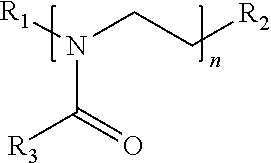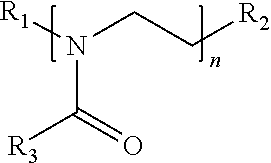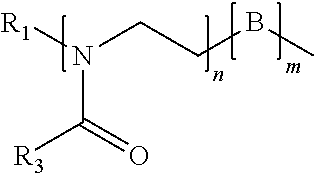Surface disinfectant with residual biocidal property
a disinfectant and biocidal technology, applied in the field of disinfectant formulations, can solve the problems of afflicting the victim, affecting the victim, and affecting the immune system of patients with weakened immune systems, and achieve the effect of durable association
- Summary
- Abstract
- Description
- Claims
- Application Information
AI Technical Summary
Benefits of technology
Problems solved by technology
Method used
Image
Examples
examples
[0107]The following examples illustrate liquid formulations made in accordance with aspects of the present invention. The testing results on these formulations demonstrate the desired residual sanitizing or disinfecting performance once being applied onto surfaces and dried. Cleaning performance is also tested on those formulations that not only provide residual disinfecting benefit but also cleaning features.
[0108]Formulations were tested for residual efficacy using the EPA01-1A protocol. Briefly, bacteria were added to a glass slide and allowed to dry on the surface. The formulation was then sprayed onto the surface and dried to form a transparent film. Once a film had formed, the glass slide was exposed to alternating wet and dry cycles using the Gardner wear tester as described in the protocol. In between each cycle the slide was re-inoculated with bacteria. After the appropriate number of wear and re-inoculations (48 passes and 11 re-inoculations for healthcare formulation and ...
PUM
| Property | Measurement | Unit |
|---|---|---|
| width | aaaaa | aaaaa |
| residual biocidal property | aaaaa | aaaaa |
| weight | aaaaa | aaaaa |
Abstract
Description
Claims
Application Information
 Login to View More
Login to View More - R&D
- Intellectual Property
- Life Sciences
- Materials
- Tech Scout
- Unparalleled Data Quality
- Higher Quality Content
- 60% Fewer Hallucinations
Browse by: Latest US Patents, China's latest patents, Technical Efficacy Thesaurus, Application Domain, Technology Topic, Popular Technical Reports.
© 2025 PatSnap. All rights reserved.Legal|Privacy policy|Modern Slavery Act Transparency Statement|Sitemap|About US| Contact US: help@patsnap.com



